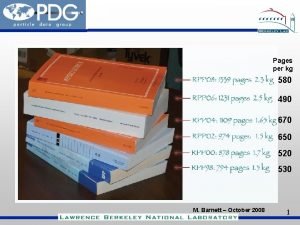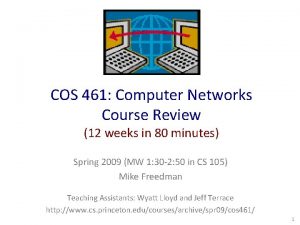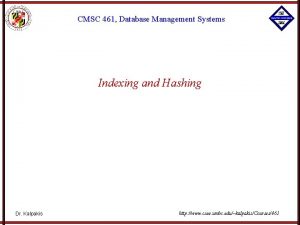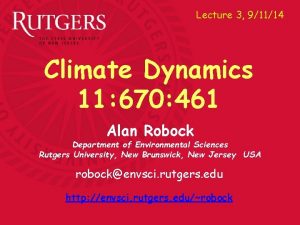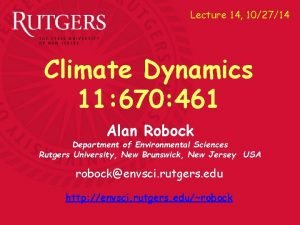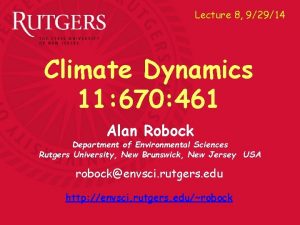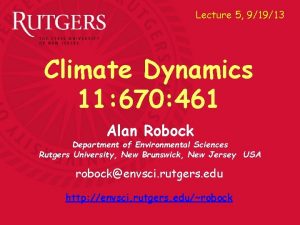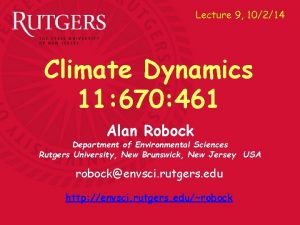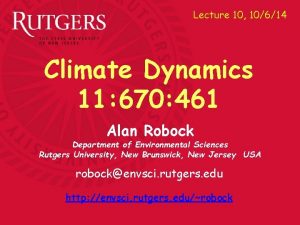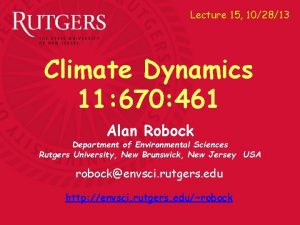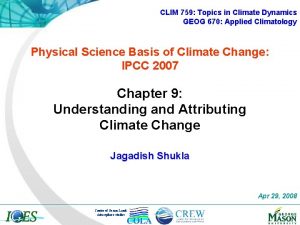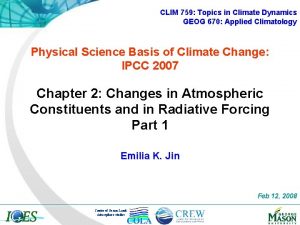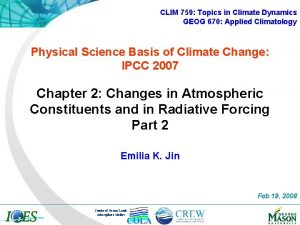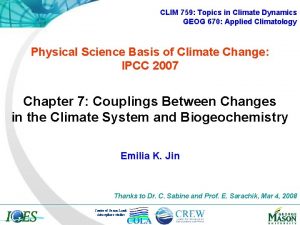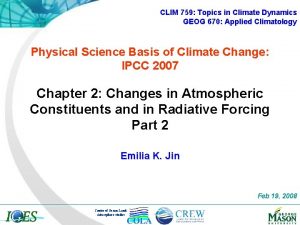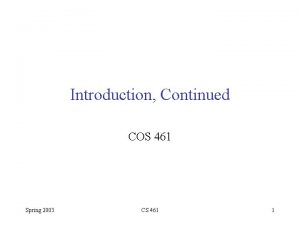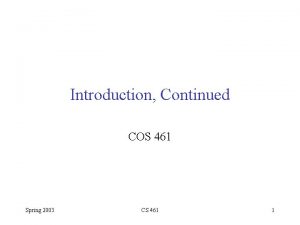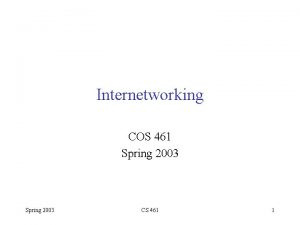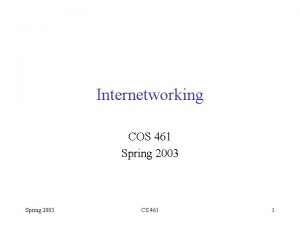Lecture 2 9913 Climate Dynamics 11 670 461

















- Slides: 17

Lecture 2, 9/9/13 Climate Dynamics 11: 670: 461 Alan Robock Department of Environmental Sciences Rutgers University, New Brunswick, New Jersey USA robock@envsci. rutgers. edu http: //envsci. rutgers. edu/~robock

But, what is a “greenhouse gas” anyway? Nitrogen (N 2), oxygen (O 2), and argon (Ar) make up for 99% of the atmosphere, but are not greenhouse gases. Water vapor (H 2 O), carbon dioxide (CO 2), methane (CH 4), ozone (O 3), and nitrous oxide (N 2 O) are greenhouse gases. A greenhouse gas absorbs infrared radiation, which creates molecular vibration and bending. Water vapor (H 2 O) vibration modes http: //www. lsbu. ac. uk/water/vibrat. html Collisions transfer energy to heat the surrounding gas. Alan Robock Department of Environmental Sciences

CCSM Climate “Forecasts” (°C) Produced by Gary Strand, NCAR Alan Robock Department of Environmental Sciences

IPCC AR 4, Chapter 1 Fig. 1. 1 Alan Robock Department of Environmental Sciences

Bretherton Diagram Fig. 1. 2 Alan Robock Department of Environmental Sciences

Bretherton Diagram Fig. 1. 2 Alan Robock Department of Environmental Sciences

Alan Robock Department of Environmental Sciences

Alan Robock Department of Environmental Sciences

Alan Robock Department of Environmental Sciences

Tropospheric aerosols mask warming (global dimming) Greenhouse gases dominate Recovery from volcanic eruptions dominates http: //data. giss. nasa. gov/gistemp/graphs/Fig. A 2. pdf Alan Robock Department of Environmental Sciences

SU CO N G SE IN RV ER AT FF Impacts on humans and ecosystems Consumption of goods and services IO N Desire for improved well-being BON REM DIOXI DE OVA L SO N BO AR Y -C RG W NE E CO 2 in the atmosphere LO Climate change ON L M AR AN R AG AD EM IA T EN IO T N TATI NCY CIE EFFI CAR ADAP Consumption of energy CO 2 emissions After Ken Caldeira Alan Robock Department of Environmental Sciences

Annual average surface air pressure. Interval 50 mb. Fig. 2. 1 Alan Robock Department of Environmental Sciences

Annual average surface air pressure. Interval 50 mb. Fig. 2. 1 Alan Robock Department of Environmental Sciences

Fig. 2. 2 Alan Robock Department of Environmental Sciences

Annual mean 900 mb geopotential height (m) Annual mean 200 mb geopotential height (m) Fig. 2. 3 Alan Robock Department of Environmental Sciences

Annual mean 900 mb geopotential height (m) Annual mean 200 mb geopotential height (m) Fig. 2. 3 Alan Robock Department of Environmental Sciences

Seasonal 900 mb geopotential height (m) Fig. 2. 4 Alan Robock Department of Environmental Sciences
 Army skill badges placement on ocp
Army skill badges placement on ocp Ar 670-1 drinking in uniform
Ar 670-1 drinking in uniform Army directive 2018-19
Army directive 2018-19 Ar 670-1 mustache
Ar 670-1 mustache Da pam 670-1 boots
Da pam 670-1 boots 650-520
650-520 Climate change 2014 mitigation of climate change
Climate change 2014 mitigation of climate change 01:640:244 lecture notes - lecture 15: plat, idah, farad
01:640:244 lecture notes - lecture 15: plat, idah, farad Power system dynamics and stability lecture notes
Power system dynamics and stability lecture notes Power system dynamics and stability lecture notes
Power system dynamics and stability lecture notes Cpsc 422
Cpsc 422 Cos 461
Cos 461 Cos 461
Cos 461 Cmsc 461
Cmsc 461 Cos 461
Cos 461 Cos 461
Cos 461 Kkk 461
Kkk 461 What did st patrick chase out of ireland
What did st patrick chase out of ireland





